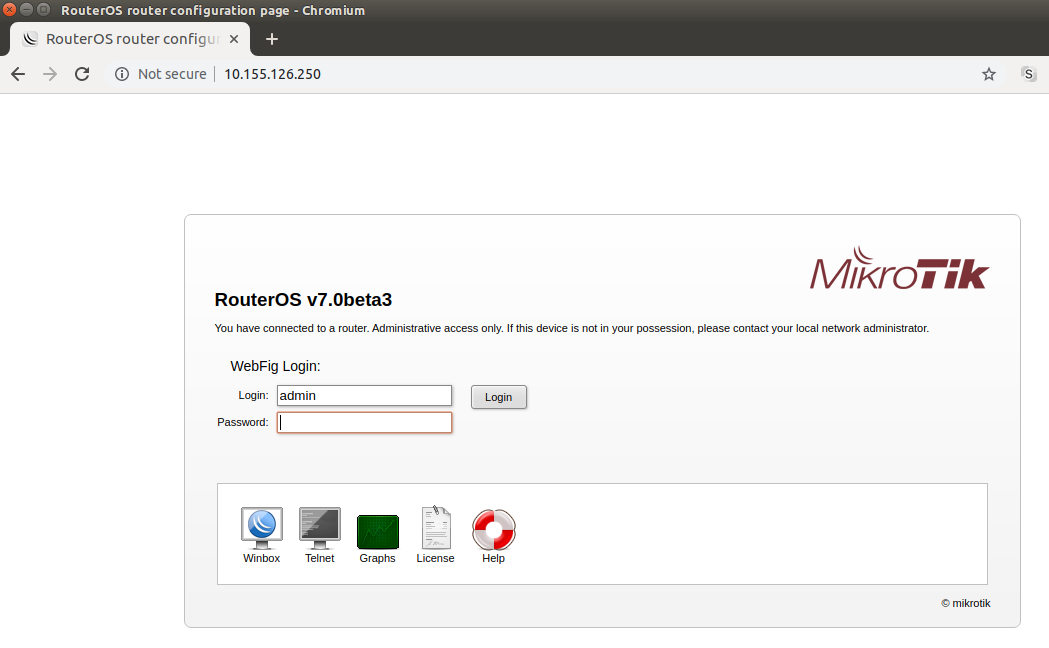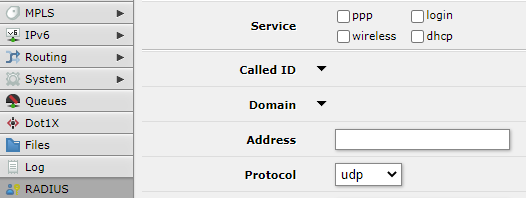- Introduction
- Connecting to a Router
- Enable HTTPS
- Skins
- Designing skins
- Skin design examples
- Using skins
- Для начинающих:Варианты подключения к маршрутизатору
- Первое подключение
- Полезные материалы по MikroTik
- Варианты подключения к маршрутизатору
- Web интерфейс (WebFig)
- Приложение (Winbox)
- Консоль
- Способы настройки
- Вручную
- С помощью файлов конфигурации
- Полезные материалы по MikroTik
- Видеоуроки
Introduction
WebFig is a web-based RouterOS utility that allows you to monitor, configure and troubleshoot the router. It is designed as an alternative of WinBox, both have similar layouts and both have access to almost any feature of RouterOS.
As Webfig is platform-independent, it can be used to configure a router directly from various devices without the need for software developed for specific platforms. In other words, there is no need to install additional software.
WebFig allows performing three basic actions:
- Configuration — view and edit current configuration;
- Monitoring — display the current status of the router, routing information, interface stats, logs, etc;
- Troubleshooting — RouterOS has built-in many troubleshooting tools (like ping, traceroute, packet sniffers, traffic generators, etc) and all of them can be used with WebFig
Connecting to a Router
As we already know from the First Time Configuration section, the device by default has username admin and no password configured. Simply open a Web browser and in the search bar type device IP address which by default is 192.168.88.1. Be sure your device has IP address from the same network, for example, 192.168.88.2 otherwise Layer3 communication will not work.
In our example, we will use IP address 10.155.126.250 to connect to the device via WebFig.
Enable HTTPS
For HTTPS to work properly, you need to specify a valid certificate that Webfig can use. You can use a certificate that is issued by a trusted Certificate Authority (CA) or you can create your own root CA and generate self-signed certificates.
Webfig supports wildcard certificates. You can generate such a certificate by specifying a wildcard in the common-name property, for example, common-name=*.mikrotik.com.
To generate your own certificates and enable HTTPS access, you must configure the following:
Create your own root CA on your router and sign it
[admin@MikroTik] > certificate add name=local-cert common-name=local-cert key-usage=key-cert-sign,crl-sign [admin@MikroTik] > certificate sign local-cert progress: done
In case you already have set up your own CA or you are using a service that signs certificates for you, then you create and sign the certificate remotely and import the certificate on the router later. In case you are importing a certificate, then make sure you mark the certificate as trusted.
Create a new certificate for Webfig (non-root certificate)
[admin@MikroTik] > certificate add name=webfig common-name=192.168.88.1 [admin@MikroTik] > certificate sign webfig progress: done [admin@MikroTik] > certificate print Flags: K - private-key; A - authority; T - trusted Columns:NAME COMMON-NAME FINGERPRINT 0 KAT local-cert local-cert 9b6363d033c4b2e6893c340675cfb8d1e330977526dba347a440fabffd983c5d 1 KAT webfig 192.168.88.1 9f84ac2979bea65dccd02652056e5559bcdf866f8da5f924139d99453402bd02
Enable www-ssl and specify to use the newly created certificate for Webfig
[admin@MikroTik] > ip service set www-ssl certificate=webfig disabled=no
You can now visit https://192.168.88.1 and securely configure your router.
By default browsers will not trust self-signed certificates, you will need to add the certificate as trusted on the first time you visit the page in your browser. Another approach is to export the root CA certificate and import it as a trusted root certificate on your computer, this way all certificates signed by this router will be considered as valid and will make it easier to manage certificates in your network.
Most Internet browsers have their own certificate trust chain and work independently from the operating system’s certificate trust chain, this means that you may have to add your own root CA’s certificate as a trusted certificate in your browser settings since trusting the certificate in your operating system’s settings might not have any effect when using your Internet browser.
Skins
WebFig Design Skin is a handy tool to make the interface more user-friendly. It is not a security tool. If the user has sufficient rights it is possible to access hidden features by other means.
Designing skins
If the user has sufficient permissions (the group has the policy to edit permissions) Design Skin button becomes available. Pressing that toggle button will open interface editing options.
To prevent the user from accessing the Design Skin menu, disable Policy «policy» under the user group configuration.
- Hide menu — this will hide all items from the menu and its submenus;
- Hide submenu — only certain submenu will be hidden;
- Hide tabs — if submenu details have several tabs, it is possible to hide them this way;
- Rename menus and items — make certain features more obvious or translate them into your language;
- Add a note to the item (in detail view) — to add comments on the field;
- Make item read-only (in detail view) — for user safety very sensitive fields can be made read only;
- Hide flags (in detail view) — while it is only possible to hide a flag in detail view, this flag will not be visible in list view and in detailed view;
- Add limits for the field — (in detail view) where it is the list of times that are comma or newline separated list of allowed values:
- number interval ‘..’ example: 1..10 will allow values from 1 to 10 for fields with numbers, for example, MTU size.
- field prefix (Text fields, MAC address, set fields, combo-boxes). If it is required to limit prefix length $ should be added to the end. For example, limiting the wireless interface to «station» only, «Add limit» will contain «station$»
- Add Tab — will add a grey ribbon with an editable label that will separate the fields. Ribbon will be added before the field it is added to;
- Add Separator — will add a low height horizontal separator before the field it is added to.
Note: Number interval cannot be set to extend limitations set by RouterOS for that field
Note: Set fields are arguments that consist of a set of check-boxes, for example, setting up policies for user groups, RADIUS «Service»
Note: Limitations set for combo-boxes will values selectable from the dropdown
Skin design examples
If you need to limit the user for some services
Add a limit to the RADIUS Service.
The result will be only those services, that are pointed in the «Limit» field.
Using skins
To use skins you have to assign skin to the group. When that is done users of that group will automatically use the selected skin as their default when logging into WebFig or Winbox.
/user/group/set your_group_name skin=your_skin
If it is required to use created skin on another router you can copy files to the skins folder on the other router. On the new router, it is required to add copied skin to the user group to use it.
Для начинающих:Варианты подключения к маршрутизатору
В статье рассматриваются варианты подключения к устройствам MikroTik: WinBox, WebFig и консольный доступ. Разбираются преимущества и недостатки каждого из способов подключения.
Первое подключение
После того как вы установили операционную систему RouterOS на ПК либо включили роутер, у вас будет несколько способов для подключения к нему:
- Доступ через интерфейс командной строки (CLI или консоль) посредством SSH, Telnet, кабеля для подключения к серийному порту или через клавиатуру, мышь и монитор если в вашем устройстве (в случае установки RouterOS на компьютер) имеется VGA карта.
- Доступ через программу управления WinBox.
- Доступ через веб интерфейс (WebFig).
На каждом роутере по умолчанию для внутренней сети используется IP-сеть 192.168.88.0/24. На некоторых моделях порт ether1 в начальной конфигурации является внешним (WAN) портом, настроен как DHCP-клиент и подключение через него невозможно. Более подробно о настройках по умолчанию для каждой модели вы можете узнать на странице настройки оборудования по умолчанию .
Как правило, по умолчанию, используются следующие настройки:
IP-адрес: 192.168.88.1
Логин: admin
Пароль: отсутствует
Подключение с помощью MAC-Telnet описано здесь.Полезные материалы по MikroTik
Чек-лист по настройке MikroTik Проверьте свою конфигурацию по 28-ми пунктам. Подходит для RouterOS v6 и v7. Дата публикации: 2023.
На Telegram-канале Mikrotik сэнсей можно получить доступ к закрытой информации от официального тренера MikroTik. В апреле и мае 2023 будут разбираться темы Wi-Fi и QoS. Подписывайтесь
Варианты подключения к маршрутизатору
Существует три основных способа подключения к устройству MikroTik:
- WebFig — веб-интерфейс
- WinBox — подключение с помощью специально утилиты
- Консольное подключение — подключение с помощью протоколов SSH или Telnet
Web интерфейс (WebFig)
Утилита осуществляющая управление RouterOS через web-интерфейс называется WebFig. С помощью нее вы можете просматривать, управлять и диагностировать состояние маршрутизатора. Доступ осуществляется через обычный Интернет-браузер. Вам необходимо ввести адрес маршрутизатора, далее ввести учетные данные и вы попадете на страницу быстрой настройки. Общий вид интерфейса представлен на изображении ниже. Смена вариантов оформления доступна только в этом способе управления.
Приложение (Winbox)
Winbox — это утилита позволяющая управлять Mikrotik RouterOS используя простой и доступный графический интерфейс. Это оригинальное Win32 приложение, поэтому под Linux или MacOS оно может быть запущено только с использованием Wine. Приложение может быть загружено как с раздела загрузок сайта разработчика http://www.mikrotik.com/download , так и с самого маршрутизатора (если вы перейдете в браузере по его IP адресу — ссылка на загрузку будет на странице приветствия и внутри web интерфейса). Подключиться к маршрутизатору вы можете используя IP адрес, а также mac адрес. Подключение с помощью MAC-адреса чаще всего используется, если IP-адрес маршрутизатора не известен либо он отсутствует.
Консоль
Доступ к консоли может осуществляться средствами — серийного порта, telnet, SSH или окна терминала в приложении Winbox. Подключиться к консоли через серийный порт, telnet или SSH можно с помощью клиента Putty.
Параметры для подключения через серийный порт(для всех моделей кроме RouterBOARD 230):
115200bit/s, 8 data bits, 1 stop bit, no parity, flow control=none by default.
Параметры для подключения через серийный порт(для модели RouterBOARD 230):
9600bit/s, 8 data bits, 1 stop bit, no parity, hardware (RTS/CTS) flow control by default.
Способы настройки
Вручную
Вы можете настраивать роутер через через графический интерфейс c помощью веб-интерфейса WebFig или приложения Winbox. Либо через через консоль, подключившись к маршрутизатору с помощью SSH, Telnet и т. д. либо запустив окно терминала из WinBox.
Начинающим специалистам в процессе освоения, как правило, удобнее работать с графическим интерфейсом, но по мере накопления опыта приходит понимание того, что настройка через командную строку происходит на много быстрее.С помощью файлов конфигурации
Вы можете использовать заранее настроенный конфигурационный файл для быстрой настройки маршрутизатора.
Полезные материалы по MikroTik
Чек-лист по настройке MikroTik Проверьте свою конфигурацию по 28-ми пунктам. Подходит для RouterOS v6 и v7. Дата публикации: 2023.
На Telegram-канале Mikrotik сэнсей можно получить доступ к закрытой информации от официального тренера MikroTik. В апреле и мае 2023 будут разбираться темы Wi-Fi и QoS. Подписывайтесь
Видеоуроки












